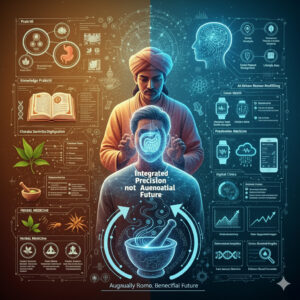A new frontier is emerging where cutting-edge technology and age-old Ayurvedic wisdom intersect, as AI revolutionizes the healthcare industry. This is a renaissance, not a replacement. It’s time to reconsider Ayurveda as a regenerating force in the digital age rather than as a relic.
The age-old wisdom of Ayurveda has resurfaced with renewed relevance in a world of fast-paced fads and quick remedies. With its longstanding emphasis on balance and customized treatment, this holistic medical approach is currently discovering a new phase in the twenty-first century. This fascinating new trend, a potent combination of ageless traditions with the data-driven discoveries of contemporary science, is aptly captured by the phrase “Ayurveda Meets.” This article will examine how this combination is paving the way for a more individualized and successful journey to wellness, encompassing everything from nutrition and exercise to mental health, demonstrating that the lessons learned from the past may hold the key to the future of health.
When Artificial Intelligence and Ayurveda Collide
A Tale of Intuitive Futures and Ancient Roots. The field of healing is undergoing a subtle change, not in the cacophonous hum of operating rooms or the antiseptic accuracy of diagnostics, but rather in the ageless realm of Ayurveda, where healing starts with breath, balance, and pulse. Ayurveda has provided more than just medicine for generations. It has provided insight into the mind, body, seasons, and inner rhythms that are frequently overlooked in contemporary medicine. But even the most seasoned practitioner must contend with the following difficult question in today’s environment of complicated health data, chaotic lifestyles, and technology overload:
Digital Vaidya Assistants and Ancient Texts
There is a great deal of wisdom in classical texts like Ashtanga Hridaya and Charaka Samhita. However, it is challenging to manually assess their relevance to contemporary pathologies or changes in lifestyle on a large scale. AI is being trained to build bridges between science and scripture using knowledge graphs and natural language processing (NLP). Translation is not the aim. It is metamorphosis, which enables Ayurvedic frameworks to remain true to themselves while adjusting to the fast-paced, complex lifestyle of the twenty-first century.
Ayurvedic Knowledge and Clinical Innovation: A Mutually Beneficial Future

Imagine entering a clinic where early indicators of Vikriti are identified and your Prakriti is evaluated based on your voice, facial traits, and lifestyle choices. It is now happening; this is not the future. Prakriti profiling becomes exact, predictive, and tailored with AI models trained on doshic principles and pattern recognition.
The New Diagnostic Lens: Moving from Intuition to Precision
Thanks to biometric analysis and sophisticated AI pattern-recognition models, we can now:
- Identify minor imbalances before symptoms appear, in keeping with the preventative philosophy of Ayurveda.
- Make individualized herbal and lifestyle recommendations based on current user data.
- With data-supported insights, Ayurvedic practitioners can strengthen and support their intuition.
Integrating Granthas into Graphs to Encode the Vedas
The preservation of logic and lineage is equally as important as translation when it comes to digitizing Ayurvedic literature like the Charaka Samhita. AI systems can be created using knowledge graphs and NLP pipelines to: Track therapy recommendations back to the original sutras, Preserve the relational integrity of ideas such as Tridosha and Dhatu, and encourage clear, verse-level explanations in medical judgments.
Purpose-driven Platforms: Ayurveda in Every Hand
Digital platforms are assisting Ayurveda in moving from scroll to screen, from conversational AI teaching Dinacharya to mobile-based dosha analysis. Wearable technology tracks Agni, mood, and sleep, proposing micro-adjustments in real time; digital clinics provide preventative treatment anywhere, at any time; and herbal inference engines guarantee that formulas are safe and appropriate for the situation, even in intricate doshic overlays.
The Meeting Point of Timeless and Current
Ayurveda will not be redefined by AI. Its purpose is to refine it. No two people are alike, according to Ayurveda; each has a distinct constitution (Prakriti), imbalances (Vikriti), and life path. Fundamentally, AI is a pattern recognition system. It can reinforce what Ayurveda already understands, which is that healing must be individualized rather than protocol-driven when it is led by ethical intelligence and age-old wisdom.
A Forward-Looking Perspective: Firm yet Flexible
Automation is not the true promise of AI in Ayurveda. Augmentation is what it is. enhancing the clarity of the healer, the comprehension of the patient, the credibility of the healer worldwide through organized proof, and the accessibility of the map for those who are looking for balance but have lost it. This is not Ayurveda’s industrialization.
The Scientific Prospects of Ayurveda
Ayurveda provides insightful information as the world’s healthcare systems deal with the problems of antibiotic resistance, chronic illnesses, and growing medical expenses. The goal of the lab-based approach is to supplement current medicine, not to replace it. The scientific validation of Ayurvedic knowledge can open up new avenues for integrative healthcare research. This entails employing natural therapies as evidence-based alternatives that can coexist with contemporary medications in clinics and hospitals, rather than merely as folk customs.
Ayurveda in the lab is a movement that symbolizes the advancement of healthcare, not merely an experiment in fusing the old and the new. Researchers are learning more profound truths about human longevity, resilience, and health by examining traditional wisdom through the lens of contemporary science.
Conclusion
In the end, the expanding popularity of Ayurvedic Meets demonstrates that traditional knowledge and cutting-edge invention can coexist. We can go past a one-size-fits-all approach to wellness and establish a more comprehensive, individualized route to health by combining the best aspects of both approaches.
Modern science’s data-driven insights combined with Ayurveda’s emphasis on prevention and balance create a potent synergy that provides a genuinely all-encompassing blueprint for wellbeing. This combination supports the notion that the best health solutions frequently occur when traditional practices and modern technology converge, enabling us to create a more robust and peaceful way of life.
FAQ
Which is the No. 1 Ayurvedic company in India?
While there is no single official “no. 1” company, Dabur India Ltd.
Which country is No. 1 in Ayurveda?
India, which is known for its traditional medicine systems, is widely considered to be the best country for Ayurveda as it is the birthplace of this ancient healing system.
Which Ayurvedic brand is pure?
The best Ayurvedic brands in India include Dabur, Himalaya, Patanjali, Baidyanath, and Zandu.
Are there any side effects of Ayurveda?
Ayurvedic medicine, a traditional system of medicine practiced in the Indian subcontinent, is considered to be devoid of adverse events.
Also Read:
Crayo AI: The AI That’s Redefining the ‘Blank Page’

I am a content writer with proven experience in crafting engaging, SEO-optimized content tailored to diverse audiences. Over the years, I’ve worked with School Dekho, various startup pages, and multiple USA-based clients, helping brands grow their online visibility through well-researched and impactful writing.


